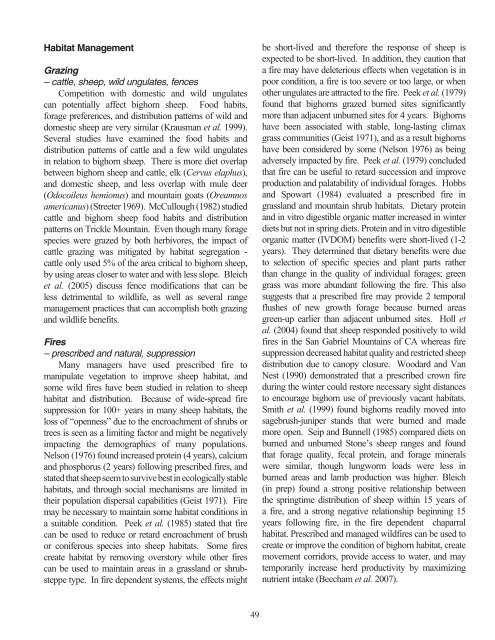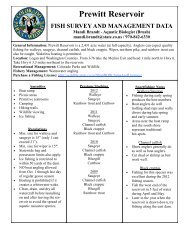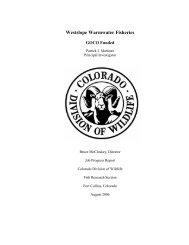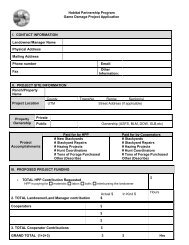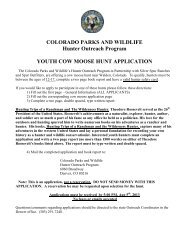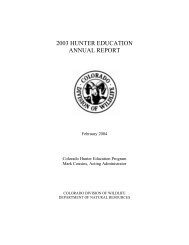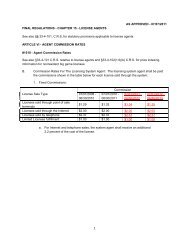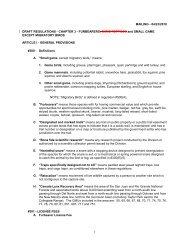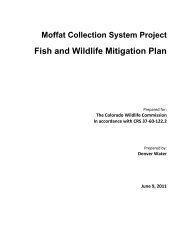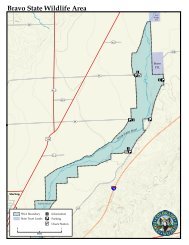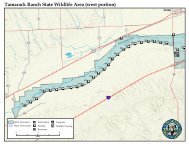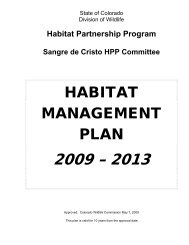COLORADO BIGHORN SHEEP MANAGEMENT PLAN 2009−2019
COLORADO BIGHORN SHEEP MANAGEMENT PLAN 2009−2019
COLORADO BIGHORN SHEEP MANAGEMENT PLAN 2009−2019
You also want an ePaper? Increase the reach of your titles
YUMPU automatically turns print PDFs into web optimized ePapers that Google loves.
Habitat Management<br />
Grazing<br />
– cattle, sheep, wild ungulates, fences<br />
Competition with domestic and wild ungulates<br />
can potentially affect bighorn sheep. Food habits,<br />
forage preferences, and distribution patterns of wild and<br />
domestic sheep are very similar (Krausman et al. 1999).<br />
Several studies have examined the food habits and<br />
distribution patterns of cattle and a few wild ungulates<br />
in relation to bighorn sheep. There is more diet overlap<br />
between bighorn sheep and cattle, elk (Cervus elaphus),<br />
and domestic sheep, and less overlap with mule deer<br />
(Odocoileus hemionus) and mountain goats (Oreamnos<br />
americanus) (Streeter 1969). McCullough (1982) studied<br />
cattle and bighorn sheep food habits and distribution<br />
patterns on Trickle Mountain. Even though many forage<br />
species were grazed by both herbivores, the impact of<br />
cattle grazing was mitigated by habitat segregation -<br />
cattle only used 5% of the area critical to bighorn sheep,<br />
by using areas closer to water and with less slope. Bleich<br />
et al. (2005) discuss fence modifications that can be<br />
less detrimental to wildlife, as well as several range<br />
management practices that can accomplish both grazing<br />
and wildlife benefits.<br />
Fires<br />
– prescribed and natural, suppression<br />
Many managers have used prescribed fire to<br />
manipulate vegetation to improve sheep habitat, and<br />
some wild fires have been studied in relation to sheep<br />
habitat and distribution. Because of wide-spread fire<br />
suppression for 100+ years in many sheep habitats, the<br />
loss of “openness” due to the encroachment of shrubs or<br />
trees is seen as a limiting factor and might be negatively<br />
impacting the demographics of many populations.<br />
Nelson (1976) found increased protein (4 years), calcium<br />
and phosphorus (2 years) following prescribed fires, and<br />
stated that sheep seem to survive best in ecologically stable<br />
habitats, and through social mechanisms are limited in<br />
their population dispersal capabilities (Geist 1971). Fire<br />
may be necessary to maintain some habitat conditions in<br />
a suitable condition. Peek et al. (1985) stated that fire<br />
can be used to reduce or retard encroachment of brush<br />
or coniferous species into sheep habitats. Some fires<br />
create habitat by removing overstory while other fires<br />
can be used to maintain areas in a grassland or shrubsteppe<br />
type. In fire dependent systems, the effects might<br />
49<br />
be short-lived and therefore the response of sheep is<br />
expected to be short-lived. In addition, they caution that<br />
a fire may have deleterious effects when vegetation is in<br />
poor condition, a fire is too severe or too large, or when<br />
other ungulates are attracted to the fire. Peek et al. (1979)<br />
found that bighorns grazed burned sites significantly<br />
more than adjacent unburned sites for 4 years. Bighorns<br />
have been associated with stable, long-lasting climax<br />
grass communities (Geist 1971), and as a result bighorns<br />
have been considered by some (Nelson 1976) as being<br />
adversely impacted by fire. Peek et al. (1979) concluded<br />
that fire can be useful to retard succession and improve<br />
production and palatability of individual forages. Hobbs<br />
and Spowart (1984) evaluated a prescribed fire in<br />
grassland and mountain shrub habitats. Dietary protein<br />
and in vitro digestible organic matter increased in winter<br />
diets but not in spring diets. Protein and in vitro digestible<br />
organic matter (IVDOM) benefits were short-lived (1-2<br />
years). They determined that dietary benefits were due<br />
to selection of specific species and plant parts rather<br />
than change in the quality of individual forages; green<br />
grass was more abundant following the fire. This also<br />
suggests that a prescribed fire may provide 2 temporal<br />
flushes of new growth forage because burned areas<br />
green-up earlier than adjacent unburned sites. Holl et<br />
al. (2004) found that sheep responded positively to wild<br />
fires in the San Gabriel Mountains of CA whereas fire<br />
suppression decreased habitat quality and restricted sheep<br />
distribution due to canopy closure. Woodard and Van<br />
Nest (1990) demonstrated that a prescribed crown fire<br />
during the winter could restore necessary sight distances<br />
to encourage bighorn use of previously vacant habitats.<br />
Smith et al. (1999) found bighorns readily moved into<br />
sagebrush-juniper stands that were burned and made<br />
more open. Seip and Bunnell (1985) compared diets on<br />
burned and unburned Stone’s sheep ranges and found<br />
that forage quality, fecal protein, and forage minerals<br />
were similar, though lungworm loads were less in<br />
burned areas and lamb production was higher. Bleich<br />
(in prep) found a strong positive relationship between<br />
the springtime distribution of sheep within 15 years of<br />
a fire, and a strong negative relationship beginning 15<br />
years following fire, in the fire dependent chaparral<br />
habitat. Prescribed and managed wildfires can be used to<br />
create or improve the condition of bighorn habitat, create<br />
movement corridors, provide access to water, and may<br />
temporarily increase herd productivity by maximizing<br />
nutrient intake (Beecham et al. 2007).


